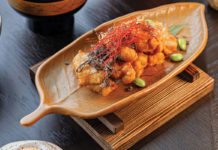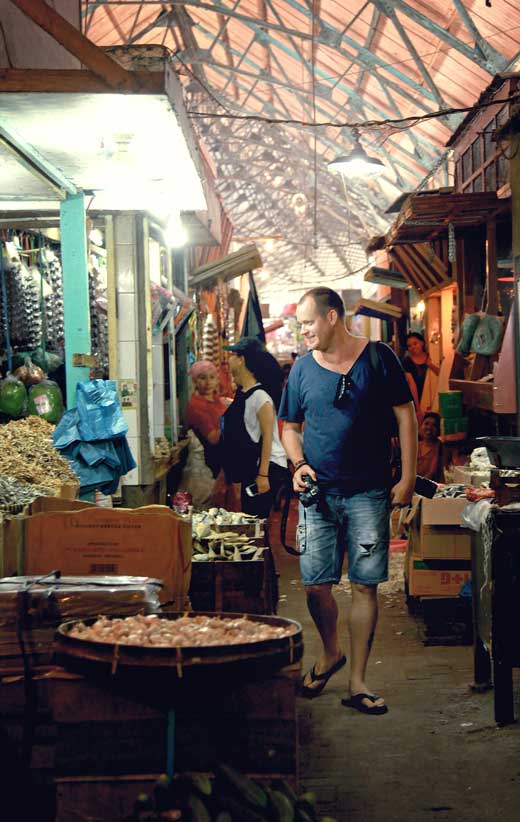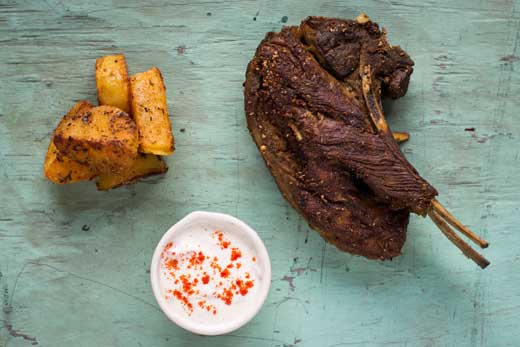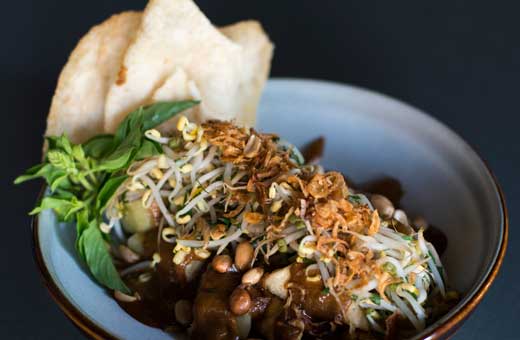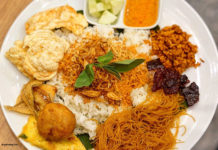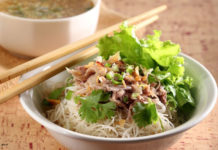A Chef’s Tale East Java
Freshly back from his culinary tours across Asia, Chef Will Meyrick’s suitcase is filled with fascinating stories and precious memories of East Java – stories of his connections with talented characters who share his passion for street food, and memories of his newfound love for the province’s cuisine.
Inspired by the Arabic influences in the flavours and textures of East Javanese dishes, Chef Will collected the traditional recipes, learned the cooking techniques, extracted the stories behind them and put his signature spin on them for Sarong, his award-winning restaurant in Bali.
On 11th November at Sarong’s intimate Kitchen Sessions: East Java, Chef Will transported us back to the markets and streets of Surabaya, Madura and other lesser-known towns with his newly inspired menu. The evening opened with elevated entrées of sate kelopo (chicken marinated in East Javanese spices and shredded coconut, served with cucumber, chilli and pickles) and Surabaya tofu salad, locally known as tahu tek, consisting of a wok-fried omelette, homemade lontong (rice cake) and potatoes served with saos kacang petis (a sauce made from peanuts and black fermented shrimp paste) and a beansprout salad.
New additions to Sarong’s mains include refined classics such as nasi bebek Madura (twice-cooked duck with mango sambal), nasi kebuli kambing (slow-cooked lamb shoulder simmered in nutmeg and cloves), 8-hour slow braised shredded beef with kluwek, beansprouts and salted duck egg, and twice-cooked cumin lamb with roasted potatoes and cucumber yogurt.
All of the dishes are beautifully elevated and meticulously prepared with a whole lot of love and respect for their origins. It is as if time has stood still and allowed us to rediscover the pleasure of eating and the significance of each dish.
The Street Food Chef in East Java
Chef Will Meyrick lives, breathes, travels and eats street food, and there is no better chef to bring Indonesia’s diverse cultures together through cuisine. We sat down with The Street Food Chef as he reminisced about discovering the pungent petis, munching on a cow’s nose and meeting East Java’s most impressive polygamist.
__________________________________________________________________
Q: What made you decide to visit East Java, and Madura in particular?
A: I have been travelling all across Indonesia for a few years now, and still, there are many regions in the country that I have not visited. I had heard a lot of things about East Java, especially Surabaya. Its history – it was a significant part of the battle for Indonesian Independence, definitely drew my attention. I had also heard about some local ingredients that I wanted to learn more about, such as petis, that make the people of Surabaya such fanatics about their food. And Madura, even though the island is actually part of East Java province, you hear so many stories, the people, the culture, the land, everything is completely detached from the main island. These aspects made me decide to check it all out for myself.
Q: Tell us about some of your most exciting culinary finds from this region. What is your favourite?
A: East Javanese food is generally challenging for me, a very particular kind of taste dominates everything else. Petis pretty much dominates, it is served in everything. Rujak cingur was the most challenging dish; that grisly, slimy cow nose was not the best-tasting ingredient I have ever tried, but I did try it! I am sure, with a little bit of a twist, I could find a way to make it super tasty. Bebek Madura and tahu tek though, were my real favourites.
Q: Who is most memorable person you’ve met on this tour?
A: Pak Haji Gozali, the owner of a kaldu sumsum stall in Madura. This man is 70 years old and has 159 wives. I was impressed by his stamina and his organization – what a task!
Q: What are two interesting things about East Java that the average person doesn’t know?
A: It really depends on what “average person” means, but for me, first, I found out that Surabaya is quite deceptive. Behind the modern façade, it’s a melting point of completely different cultures; Javanese, Madurese, Bugis, Chinese and Arabs live side by side and influence each other. The other thing is that Sate Madura is the hardest dish to find there in Madura.
Q: Please share with us the best moment of your entire trip.
A: Scouring the Pabean traditional market. The people, the atmosphere, the overall ambiance, it sent me back to some fantastical historical time, like travelling in a time machine. I remember clearly the gypsy looks of the Madurese women, with thick black eye liner. They laughed and danced in front of me.
Q: What’s the most useful item you’ve bought?
A: I did not buy anything. I bought food and some ingredients, probably petis, as I used it in my kitchens.
Q: What’s the weirdest thing you’ve seen there?
A: When you have an open mind to travel and experience culture there is nothing the world that is weird, not really; there are differences, but they are not weird.
Q: Finish this sentence: When in Madura…
A: I felt like an alien, people stared, almost with a suspicious look, but they immediately started smiling and laughing when they realized I was trying to talk to them. They welcomed me warmly when they knew I wanted to try their food and learn the culture from them.
Q: What do you love most about travelling?
A: Getting to know people and their lives through their food.
Q: What can’t you travel without?
A: Patience and an open mind.
Q: What’s the best piece of travel advice you’ve received?
A: Sew a pocket inside your jeans and always carry small change. You might need it in some places, probably a place where the people ask for a fee for a photograph of them.
Q: Who do you miss the most when you travel and what’s the longest you’ve been away from home?
A: My family, of course, they are my anchor in life, and the longest we have been separated is for one month.
Q: What did you learn about yourself from this trip?
A: From this trip and every trip, I reignite my insatiable curiosity, I feel like I discover my love of travel each time I arrive somewhere new, and in a way I rediscover my “self”, the part of me that is open to the adventure.
Q: What’s your next culinary destination?
A: Life is that exciting, I am not even sure, I’d like to discover more of Malaysia. I have some historical family ties to the country I’d like to uncover…
Surabaya Tofu Salad
Main ingredients:
- 1 piece tofu, fried & cubed
- ½ tsp white pepper powder
- 1 tsp salt
- 2 eggs
- Potato, boiled
- Lontong (rice cake)
- Short bean sprouts, blanched
- Oil for frying
Peanut sauce Ingredients:
- 1 teaspoon salt
- 5 tbsp peanuts, fried
- Small red chilli, as desired
- 2 pieces red curly chilli
- 2 pieces garlic whole, fried
- 1 tbsp prawn petis
- 2 tbsp sweet soya
- 1 tbsp palm sugar, grated
- Water
Lontong Ingredients:
To make 7 – 8 lontong
(rice cake):
- 2 cups uncooked rice,
- washed & drained
- Banana leaves
- Tooth picks
Garnish:
- Fried shallots
- Asian celery, finely sliced
- Green shallots, finely sliced
- Lime cheek
- Prawn crackers
- 1 tablespoon peanut, crushed
Method:
- Whisk salt and white pepper powder into the eggs to make the omelette mix. To make the omelette, heat oil in the pan and when it is hot, add in the egg mix and stir when the egg is starting to stick. Then fold it so it comes together like a roll.
- To make the peanut sauce, blend all the ingredients together. If the paste is a little thick, add some water, this will help to get a smoother consistency.
- To make the lontong, clean the banana leaves with clean damp cloth before using. Cut 7-8 pieces of 25cm width. Warm them up a little bit on an open fire briefly. This is a very important step as it helps the banana leaves to stay soft and avoids cracking.
- Roll each leaf (lengthwise with the green shiny side in, so your lontong will have a slightly greenish colour) into a cylinder with a diameter of about 15cm. Secure one of the ends with toothpicks.
- Put rice into each roll. The amount of rice depends on the length of your rolls, you want to put in rice to less than half the length. If you have a 20cm long roll, put less than 10cm of rice in. This will make sure you don’t have tough lontong. You will be able to make about 7-8 rolls.
- Prepare a big pot, tall enough to cover the lontong all the way to the top. This is also another important step, as the lontong must be cooked “standing” inside the pot.
- Do not use plastic, as it will melt!
- Cook for a minimum of three hours with the lid on. Let them cool for about one hour before opening and slicing them.
- For the prawn crackers, heat the vegetable oil until hot. You can test by adding in bread or rice. If it sizzles then you know you are ready to add the dried crackers.
- Put the omelette on the plate, arrange the tofu cubes and lontong cubes on top of the omelette and drizzle peanut sauce over the ingredients. Garnish with bean sprouts, Asian celery, green shallots and fried shallots. I like to finish it with crushed peanuts and add the prawn cracker on the side with a slice of lime.




